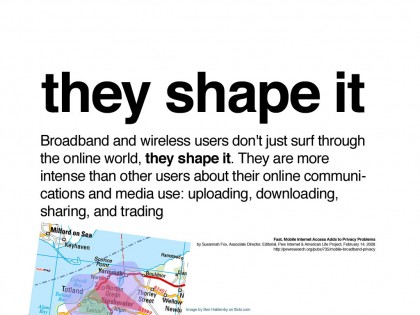Having a dark age discussion with a client a couple of weeks ago considering removing visuals from a website because it was perceived to “heavy” for non-broadband visitors. Set of some thoughts regarding how important and limiting “narrowband” (0-128Kb) is as a “feature/attribute” when designing target groups.
Disclaimer:Norway is in the top 5 when it comes to broadband penetration in the world. Research from Internet World Statistics found broadband had a 88% penetration rate in 2007.
So, the question arose: “are non-broadband users even in the target group?”
Now it seems we often are asked to define target groups based on demographics like age, gender, income rate, children, age of children etc. And even if these say something, they have three important weaknesses that I find outplays the positive:
- 1. Demographics on it’s own depends on each person in the project to create their own personal interpretation of the target based on their own experience, attitudes and stereotypes.
2. Even though we can draw a generic understanding of these target groups, they overlap and infiltrate each other. Demographics are diffuse. And I would say they create a sloppy and ineffective understanding of who we are going to talk to – and leading from that also what we should say in order to get them to do something (incentive-action)
.
3. Using demographics is very easy because it allows us to end up with an understanding that is close to what you already believe, and possibly also can relate to. This is counter productive in or search for new creative solutions, and might be horribly wrong.
So what about “broadband” as an attribute? Is broadband only about speed and effectiveness, playing into participants decreasing amount of attention and tolerance? Or can we say that the technology being used to access the content actually tells us more about the customer than a lot of traditional demographics can?
Jeffrey Cole, head of USC Annenberg School Center for the Digital Future, stated at a presentation back in 2006 that moving from Narrowband to Broadband carries greater changes then moving from nothing to Narrowband
phosphodiesterase type V (PDE V) inhibitors or nitric oxideMixed, buy viagra online.
.
The reason being that participants with broadband are always on, and have no restrictions concerning price (because it’s set).
Cole presented the analogy that narrowband user go on the Internet two or three times a day, and solve tasks written down on the back of an envelope for forty minutes before coming back to reality. Now a broadband user is online 40 times a day for two or three minutes – the Internet is totally integrated into their everyday lives.
We also know that broadband users not only read and solve tasks on the web they want to shape it:
- Broadband and wireless users don’t just surf through the online world, they shape it. They are more intense than other users about their online communications and media use: uploading, downloading, sharing, and trading.
– Pew Internet & American Life
A website for broadband users is all about experience, next generation content and visual storytelling. It’s a richer universe communicating with the participant in a way that establishes, and builds story and brand.
Narrowband users are task solvers, with a predetermined schedule. They are at the end of any purchasing cycle and just wants to get over and done with it – they want to get back to their lives.
Broadband users don’t differentiate between real life and digital reality, it’s all a part of their everyday environments and habits.
Is it possible to build a solution for both that isn’t a committee decision meeting everybody half-way?
(It’s a bit un-nuanced and polarized, but an interesting thought, I hope :o)


Interesting thought. But given the general seachange, anyone with broadband in -say – 12 months is a refusenik. And is the opportunity cost of including them worth it?
Thank you for the comment Simon. I’m guessing you mean “without” broadband is a refusenik?
My point as well as yours… Is the opportunity cost of involving them having to build two different web experiences?